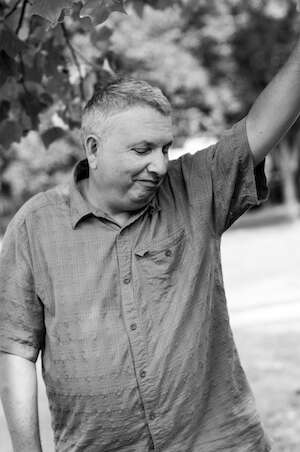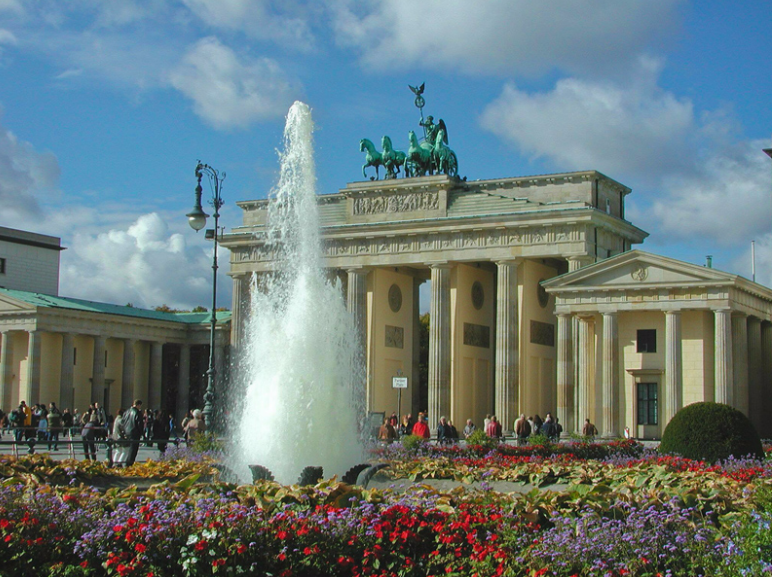

 The following article about Potsdam, adjacent to Berlin and a key destination of the Berlin Wall Cycle Route, was written by BikeTours.com president Jim Johnson and published in 1998. Much of the information--other than prices and currency--remain true today. See tour details here.
The following article about Potsdam, adjacent to Berlin and a key destination of the Berlin Wall Cycle Route, was written by BikeTours.com president Jim Johnson and published in 1998. Much of the information--other than prices and currency--remain true today. See tour details here. For nearly 40 years, Potsdam lay behind the Iron Curtain, a jewel of a city hidden to most of the world. Sadly, although the curtain has lifted, few Americans take the time to visit and most of them only on sightseeing buses from adjacent Berlin.
That’s a shame, since this UNESCO World Heritage city is a true treasure.
It’s rare that such a wealth of history—old and recent—and such a concentration of architectural treasures lie within so small an area. During a period of barely three centuries, Prussia’s Hohenzollern kings built an amazing collection of palaces, parks and gardens. In the extensive parks surrounding the city, the Hohenzollern kings commissioned palace after palace, all set in carefully designed landscape gardens. In the 19th century, renowned landscape architect Peter Joseph Lenné unified the palaces and gardens into the harmonious landscape of palaces and gardens that visitors enjoy today.
Most are within walking distance of each other—walks that cross a stunning landscape of 19 lakes, two rivers and expansive hills, forests and gardens. In fact, more than half of Potsdam is either forest or park.
As awareness of Potsdam grows, increasing numbers of visitors are opting to overnight in Potsdam and do day trips to Berlin instead of the more “traditional” other way around. Room rates and restaurants are considerably less expensive and generally more familiar. Visit a restaurant or pub twice in Potsdam, and they’ll know you.
“Berlin is masses of people,” said one American visitor I met in a Potsdam bookstore. “For me, Potsdam fills the same need that it did for the 18th-century kings. Potsdam is a refuge, a peaceful place. I can spend hours exploring the parks, and I never hear a car horn or see a traffic light. If I want big-city action, I can be in the heart of Berlin within 25 minutes by S-Bahn or train. In Berlin, the evenings belong to the young. I’d rather stay in Potsdam.”
That doesn’t mean Potsdam is a sleepy backwater. As capital of the State of Brandenburg and as a university town, Potsdam is lively by day or night. Potsdam also benefits from an overflow from Berlin of students and international residents. Therefore, despite being a city of barely 130,000 inhabitants, Potsdam can offer a surprising variety of dining (and drinking) choices.
Many of those options are in the Baroque Dutch Quarter, a group of red-brick, gabled houses built in the early 18th century to attract Dutch tradesmen. The four-block district is filled with courtyard restaurants, cafés and pubs like M18, Hollow Pear, Flying Dutchman, La Maison du Chocolat and Café Heider. Adjacent to the Dutch Quarter is Brandenburg Street, an 18th-century residential area built to house both families and Prussian troops—six soldiers to a household. Today, Brandenburg and neighboring streets have been transformed into wide pedestrian boulevards filled with smiling shoppers, and many of the houses into eclectic book stores, antique shops and bistros.
Many visitors to Potsdam also discover a poignancy of the more recent past, starting with the Potsdam Conference, which in many ways set the stage for the division of Germany. That drama played out quickly with the Russian occupation and the creation of the German Democratic Republic. Signs still remain from those times, which after all ended a scant 14 years ago. As recently as 1994, the city still had 60,000 Russian soldiers. Those interested can wander the former “Forbidden City,” a walled-off villa district once controlled by the KGB, and the KGB prison, now regional headquarters for Amnesty International.
Potsdam also presents an excellent case study of a former East German city adjusting to life in unified Germany. Most notably for tourists, many significant structures were torn down by the government or fell into neglect. Many attractions that you can visit today have been open less than a year, with restoration work funded by foundations and public figures. Work continues in other areas, including around the ruins of the City Palace, built in 1662, severely damaged in 1945, and almost fully demolished in 1961.
But, for most visitors, it’s Sanssouci that’s the prime attraction. Sanssouci Park alone covers 724 acres—compared to Central Park’s 840—and has three palaces: the rococo Sanssouci Palace, the Baroque New Palace and Charlottenhof Palace.
A king who joined his troops on the battlefield, Frederick the Great commissioned Sanssouci Palace in 1747 as a summer palace where he could have a respite from battle sans souci—without worry. You can see his fatigue in the many statues: the warrior in marble, his sword in its sheath, his shield down, a look of weariness on his face.
Most of what visitors see is the ornate original—not reconstructions or duplicates—and perhaps German’s most impressive example of rococo architecture. In front of it, vineyard terraces stretch in geometric shapes into the park.
Over the coming century, descendants made their mark on Sanssouci Park with new constructions: like the New Palace, a massive, 200-room Baroque masterpiece built after the Seven Years’ War to demonstrate Prussian pride—and in response to the palace at Versailles. The neo-classical Charlottenhof followed in 1826. A visual highlight then and now is the Orangerie, a 300-meter-long palace built to house large tropical plants—including 450 potted trees—during the winter. During warmer weather, the grounds in front of the Orangerie become a Mediterannean garden complete with palm trees.
Many visitors to Sanssouci Park neglect the smaller but exquisite New Garden, built as an English landscape garden in the late 18th century. Many Potsdam residents actually prefer the park, a strip of green space between two lakes—the Heiliger See and the Jungfernsee. Relatively few tourists come to the park, although it provides the setting for two charming palaces from two different eras: the Marble Palace, a Baroque masterpiece from the late 18th century, and Cecilienhof, the final Hohenzollern palace, built in 1917 in the style of an English country estate.
Although Cecilienhof is the youngest of the Hohenzollern palaces, it carries perhaps the greatest direct significance for Americans and modern Europe. It was here that the Potsdam Conference took place from July 17-August 8, 1945, to address issues related to post-War Germany. What we take for granted today was still being defined and surmised in 1945. In many ways, the future of Germany was negotiated there—and with that future, the hopes and opportunities not just of one nation but of Europe and the world. In many ways, the Cold War started in Cecilienhof.
Much of Cecilienhof remains as it was in 1945. The conference room is as it was, its circular table ringed by chairs. Flowers still form a large red star in the entry courtyard. The offices of Stalin, Churchill and Truman have been preserved as well, and visitors can almost feel the personalities of the people involved, especially Stalin in his red, no-nonsence office that was almost brutal in its plainness. Visitors can also see some of the games-playing that went on—such as the chair that Stalin moved into Churchill’s study that was too small for the rotund statesman. It was also at Cecilienhof that Truman got word that the A-bomb was ready and gave the order to bomb Nagasaki and Hiroshima.
Even less visited than the New Garden is Babelsberg Park, just across the Havel River. Located on a bluff, Babelsberg Palace built in the early 19th century in English Tudor Gothic style, offers a commanding view of the Havel landscape and ample opportunities to explore the romantic park. Babelsberg is also adjacent to one of Potsdam several villa neighborhoods, their expansive Jugendstil homes reflecting the relative wealth of the late 19th and early 20th centuries.
Some proud residents joke that Potsdam is “Prussian Disneyland” due to rich representation of other countries and cultures such as the Chinese Teahouse, the Dragon House, and the Roman Baths, the Italian gardens around Charlottenhof and, of course, the Dutch Quarter, the Mosque, and the Orangerie in the Sanssouci Park, modeled in part on the Villa Medici in Rom. Then there’s the Russian Colony Alexandrowka, with its 13 houses built in 1826 for Russian singers left behind after Prussia and Russia were victorious over Napoleon’s troops.
After extensive restoration, the faux Italian village at the royal estate Krongut Bornstedt re-opened in June 2002 looking much as it did 150 years ago and selling many of the same goods. There’s a wood-oven bakery, a candlemaker, a glassblower, a potter and a jeweler. Everything sold there is created on premises, right down to the tailor shop with its whirring sewing machine and to the “Bornstedter Bueffel” (“Bornstedt Buffalo”), a rich, frothy brown beer brewed as it was in the 17thcentury.
The best time to visit Potsdam is from May through October, although the end of July through August can be hot and humid. The fewest tourists come in May and October and, with the flowers in full bloom, May and June are perhaps the most colorful.
For the parks—especially the palaces—go early in the day. This isn’t just to avoid crowds but also total disappointment; as part of the preservation process, the palaces are limited to a certain number of people coming through each day. When they reach that number, they close. Pay attention to which palaces are open on which days, since each castle closes on a different day. The New Palace is the only palace open on Mondays. Don’t neglect the less popular palaces—historic and architectural gems that often offer no lines, no waiting.
While the parks and palaces are the prime attraction, set aside some time to walk around the Baroque Old Town. Also, some of the best views of the parks and palaces are from the lakes and river. Relaxing cruises are available of different lengths and routes, from 90-minute lake tours to full-day excursions from Potsdam to Berlin and back.
For English-speaking visitors, Potsdam does present a few challenges. The city and tourism websites are in German, and public sightseeing tours are in German only. For that reason, you may want to consider hiring a private guide, especially if you have specific interests in history, architecture or culture—and don’t mind spending €120-150 ($130-163) for a half-day. In addition, many of the city guides are also allowed to provide private tours of the palaces. This can cut considerable time from waiting or even seeing attractions that aren’t of particular interest. The tourist office—which does speak English—can help locate and hire an appropriate guide. On a recent visit, Kevin Kennedy, an American who has lived in the Potsdam area most of his life and is working on his doctoral thesis relating to German history, was superb with his knowledge, passion and insight.
Potsdam features an extremely efficient and comprehensive public transit system of trams and buses, which also connect with the S-Bahn and regional rail systems for travel to Berlin and throughout Brandenburg. Probably the least expensive way to explore Potsdam is on bus route 695, which makes an almost full circle past the major sights. Buy a one- or multi-day pass (from €3/$3 for one day to €10/$11 for a week), step on and off at leisure, and explore.
This article orginally appeared in Gemutlichkeit Travel Newsletter about travel to Germany, Switzerland and Austria.